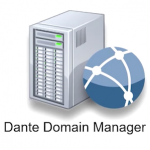Recently we published a piece inspired by conversations with customers about Audio over IP, the marked increase in adoption in Post, and the three main driving factors.
While Dante neatly addresses these everyday bottlenecks, engineering and security headaches – opening up Dolby Atmos workflows along the way – the feedback from customers was often edged with a plaintive frustration.
With many large post houses and broadcast facilities spread out over multiple premises and working remotely, the frustration stems from a yearning for functionality that Dante simply doesn’t offer:
If only we could use Dante over distance, transcend the local area network and send multichannel audio at full quality between sites, across town, country or continent!
Turns out we can. Here’s how.

Back in December 2019, Resurface attended an intriguing world-first experimental performance at the University of West London. Curated and designed by AoIP and Dante over distance pioneer Dr. Paul Ferguson (pictured) of Edinburgh Napier University, the performance featured a group of eight musicians performing together, from separate rooms, all using Focusrite RedNet (Dante) interfaces. Each player routed to front of house, each furnished with a headphone mix.
So far, so familiar.
The world-first part was that one of the musicians in the band, a keyboard player, was in Edinburgh. 400 Miles away!
The experimental workflow we witnessed that night has since been repeated, this time between Edinburgh and Berlin, some 1000+ miles apart. Not dissimilar to New York and Nashville, Paris and Barcelona or Mumbai and Chennai.
The traditional line has always been that this can’t be done with Dante. The reason has always been clock. Any digital audio system requires solid, consistent, low jitter clock to function, Dante networks are no different. Sending audio ‘wild’ over the internet isn’t difficult. Ensuring the integrity and sync of clock packets at either end has always been the show-stopper. No clock = no audio = no point.
Dr. Ferguson’s ‘eureka moment’ was a piece of lateral thinking triggered by two new features added to Audinate’s Dante Domain Manager (DDM) in the September 2019 release. These two features are:
- Support for SMPTE 2110 / AES67 compliant devices in Dante workflows
- Support for GPS Synchronisation

Earlier versions of DDM already allowed for routing Dante between devices across different ‘Zones’. Zones are (generally) local, logical groupings of devices in different network subnets or physical sites. By itself, this isn’t a solution to Dante over distance, because the clock issue remains un-addressed.
When combined, the two new features pave the way to removing the barrier of clock in Dante over distance workflows. The broadened compatibility definition of ‘AES67 Compliant’ brings a far wider spectrum of technology into play. Included in this wider selection is an innocuous-looking 1U box by Sonifex, the AVN-GMCS IEEE1588, a PTP GPS Grandmaster Clock for AoIP.
DDM allows for each zone to be governed independently by its own master clock, keeping the devices at each site happily synced and passing audio.
The key, then, is the Sonifex GPS clock. Every GPS satellite in orbit around the earth contains an ultra-precise atomic clock which generates and transmits UTC (coordinated unified time). Being atomic clocks, the time they tell is accurate to within 10 nanoseconds. Being UTC, it’s the same time.
Dr. Ferguson’s idea was to incorporate a Sonifex GPS clock on the local Dante setup at each site (zone) and designate it as the master clock for that zone. Because each GPS clock derives the same – exactly the same – time from whichever satellite(s) it sees, the Dante audio devices in each zone were effectively clocked locally, but identically.
With clock limitations overcome, a Dante network can perform over any distance, passing the full bi-directional channel count without a glitch.
Only latency remains an issue.
How big of an issue, though? For remote applications where high channel count audio is being sent in one direction, latency is obviously less of a concern. Relying on ‘the internet’ – where the user has no insight or control over traffic levels or the data’s journey from place to place will certainly make latency an issue.
But then again, most of the customers we spoke with who were lamenting the single-site limitation and excited by the possibilities of Dante over distance were also customers who had invested in dedicated, high performance connectivity between their sites. Across town, from LA to London, or for remote and OB production. Here, latency will likely be manageable.
Most excitingly, this isn’t a sci-fi glimpse into the future. Certainly it’s not common practice and the pieces of the technology puzzle aren’t yet ‘oven-baked’ or ‘productized’ as a turnkey solution – but every piece of hardware and software required to run Dante over distance is off-the-shelf and available now from a knowledgeable Audinate, Focusrite Pro and Sonifex dealer near you.
Full technical details and system diagrams from December’s event can be found in Focusrite’s case study here.



